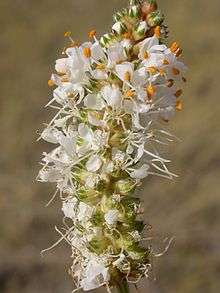Dalea candida
Dalea candida is a species of flowering plant in the legume family known by the common name white prairie clover. It is native to North America, where it can be found throughout central Canada, the central United States, and northern Mexico. It can sometimes be found outside its range as an introduced species.[1] It grows in many types of habitat, including several types of prairie, foothills, woods, forests, and disturbed areas.
| Dalea candida | |
|---|---|
 | |
| Scientific classification | |
| Kingdom: | |
| (unranked): | |
| (unranked): | |
| (unranked): | |
| Order: | |
| Family: | |
| Genus: | |
| Species: | D. candida |
| Binomial name | |
| Dalea candida Michx. ex Willd. | |
| Varieties | |
| |
It is a perennial herb growing erect to a maximum height around 1 meter (3 ft 3 in), its taproot growing up to 5 or 6 feet (1.5 or 1.8 m) deep.[2][3] The alternately arranged leaves are each composed of several narrow, gland-dotted, light green leaflets. The inflorescence is a dense cylindrical spike of flowers at the tip of each stem or stem branch. The spike is packed with the pointed green calyces of sepals, the lower ones bearing corollas of white petals and the higher ones blooming later. The fruit is a green oval legume pod containing one seed.
A specimen of this species was collected by Meriwether Lewis in Nebraska in 1804.[4]
Uses
Among the Ramah Navajo, the candida variety is used for stomachache and as a "life medicine", especially for fever. A compound decoction used to treat "snake infection" in sheep.[5]
Ecology
It is popular with pollinators and, as it is a legume, it is a nitrogen fixer. It is a larval host to the clouded sulphur, marine blue, Reakirt's blue, and southern dogface.[6]
References
- "Dalea candida". Germplasm Resources Information Network (GRIN). Agricultural Research Service (ARS), United States Department of Agriculture (USDA). Retrieved 16 January 2018.
- Hilty, John (2016). "White Prairie Clover (Dalea candida)". Illinois Wildflowers.
- Haddock, Mike (2018). "White prairie-clover". Kansas Wildflowers and Grasses.
- Schiemann, Donald Anthony, Wildflowers of Montana, page 180. Mountain Press Publishing Company, Missoula, 2005.
- Vestal, P. A. (1952). "The ethnobotany of the Ramah Navaho". Papers of the Peabody Museum of American Archaeology and Ethnology. 40 (4): 33.
- The Xerces Society (2016), Gardening for Butterflies: How You Can Attract and Protect Beautiful, Beneficial Insects, Timber Press.
